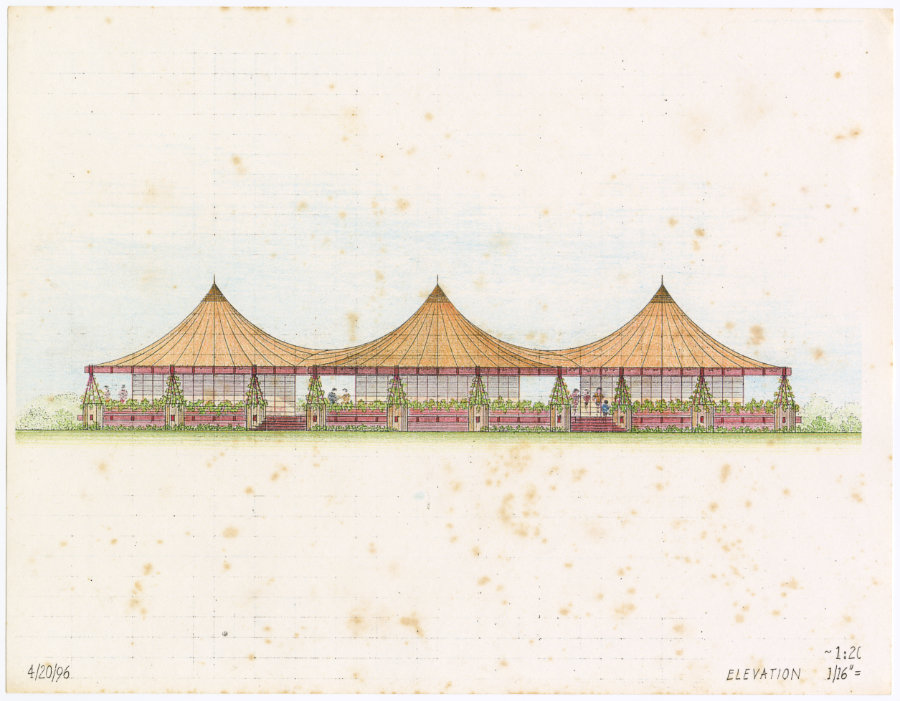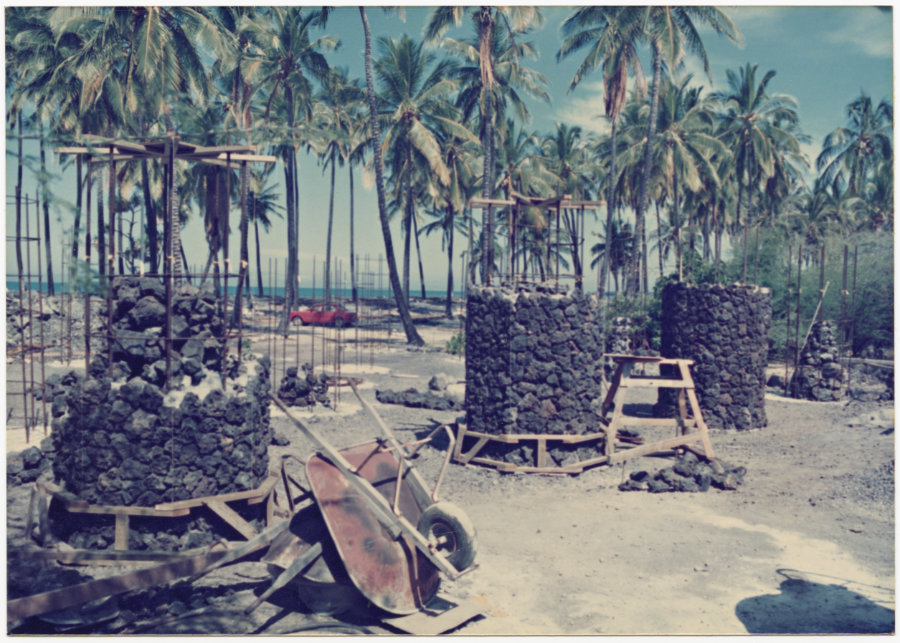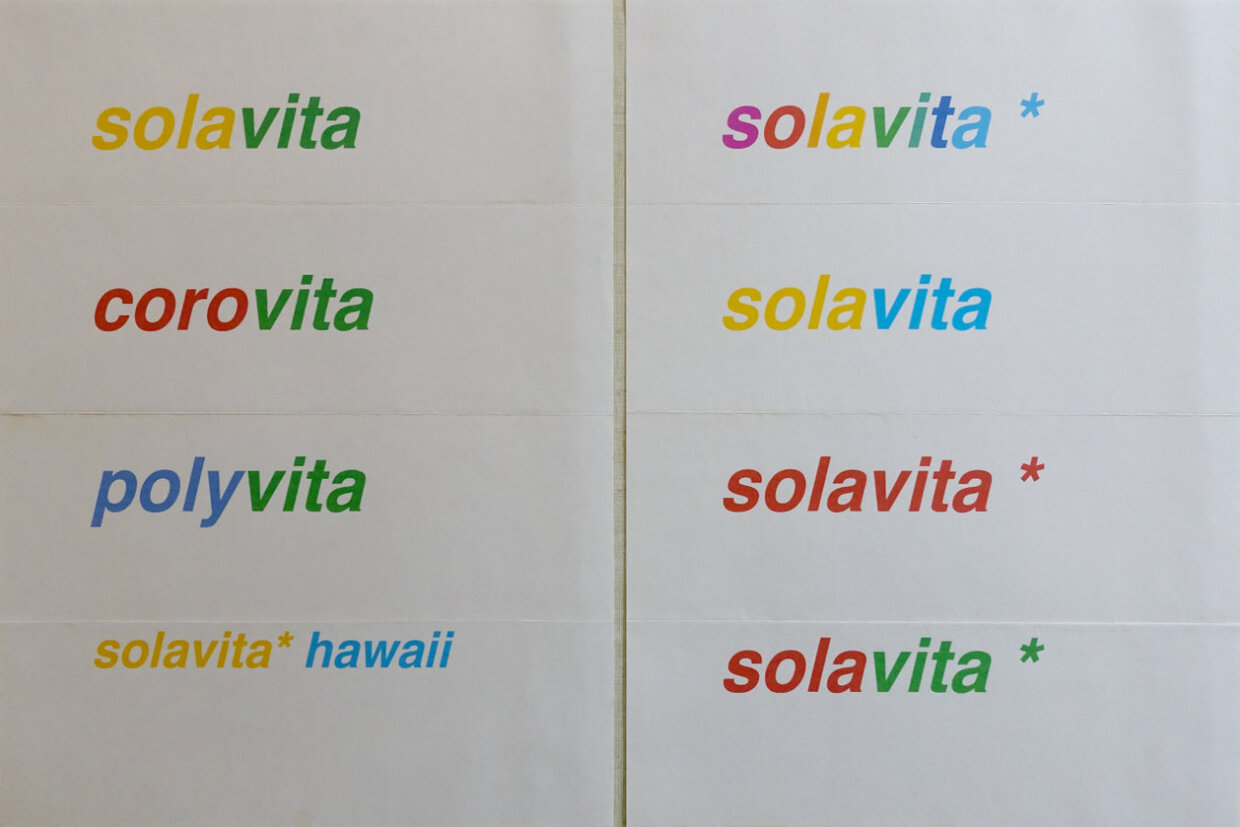Colored elevation of the four-mast house on Conrad Roland's property above Kailua-Kona, Holualoa (left side). Only the foundations and masts remain as evidence of the planned construction – the building itself was never completed (right side).
‘'Rolly, what did you build?' – 'A four-mast super rope circus, even two.' – 'Where is the four-mast house with the spacenet roof covered with passion flowers?' – 'Hm, unfortunately not built, it was too big for me and too expensive and too cool up there in Holualoa 300 m above sea level. 'Why didn't you build the spiral high-rise? You would have been awarded the Pritzker Prize for it. Sorry, unfortunately you have to go to the architects' hell, it's nice and warm there for you and you have to catch flies as a spacenet spider for the 'devil of mediocre architects' ...’ 1
With a fictional dialogue before the Last Judgement, Conrad Roland took stock in March 2020 to prepare for his entry into the ‘(architectural) paradise’ 2. In the meantime, he had been living a secluded life in Hawaii and, in this self-deprecating dialogue, he not only took stock of his own work, but also of the conventions and values of his profession. He looked back laconically: What could he realise? What remained a vision? And what actually constitutes architecture? Laconically, he looked back: What was he able to realize? What remained vision? And what actually constitutes architecture?
New beginning on the Big Island - As early as 1969, a lecture tour had taken him to Hawaii. He later described what he experienced there as the discovery of a ‘new world’, full of ‘a splendour of colors, forms, and sensuality’. 3 This fascination would not let him go. In 1987, two years after selling his company, Roland moved to the Big Island. He had the plan to build the four-masted house with the spacenet roof covered with passion flowers there. 4 The building was not realised, but the design was the logical continuation of his development from the utopian visions of the suspended city to the play spacenets to his own residential building.
After two years as a macadamia farmer, Roland left his adopted home again – disappointed by the political and social conditions in America. His next stop: Tahiti. There, too, he dreamed of a four-masted house by the sea. He also planned and designed there. And there, too: no realization.
He finally returned to Hawaii with two containers full of books, drawings and Mies furniture as well as his pick-up.
Landscape as a way of life - In 1992, Roland took up his project for a four-mast house on a plot of land above Kailua-Kona (Holualoa) again – this time on a larger scale and with comprehensive landscape design. In the design of the 20,000 square metre area, he combined landscape architectural design with practical gardening. He planted citrus trees, bananas, mangoes, palm trees and tropical flowering plants and tried to create a functioning ecosystem – a ‘paradise garden’, as he called it. In his long letter to Frei Otto in 1995, he writes:
‘For exactly one year I have been planting the originally almost bare property, day after day: 80 grapefruit trees, hundreds of bananas [...] and especially many indigenous, 'endemic', Hawaiian plants ... Sometimes I was truly desperate, the tropical weeds wanted to strangle me, despite the drought. Now the rainy season has finally come after almost sixteen months of drought and everything is growing magnificently and the gardener is happy.’ 5
The building was again planned down to the last detail and the foundations were laid, but for health and financial reasons it was ultimately not realized.
Between architecture, science - Over time, Roland's interest increasingly shifted to scientific topics. He regularly read journals such as Nature and Science, dealt with molecular biology and astronomy and developed a dietary supplement for skin care. Under the name Solvita, he had it registered as a ‘dietary supplement’ in several countries. The goal was a plant-based formula that would prevent sun damage and reduce various signs of aging. Here, too, Roland combined nature-based observation with a design sensibility: he designed the packaging, the logo and the advertising materials himself. He called his ‘golden formula’ PhytoGold.
Marked by age, Roland increasingly withdrew from active design. With the sale of his property in Holualoa, he also gave up the dream of his own four-mast house. Until the end, he was primarily concerned with knowing that his estate was in good hands and accessible for research.
Conrad Roland died on September 25, 2020 in Keauhou, Hawaii.
Aftermath - Roland's time in Hawaii was marked by experiments, ruptures, unrealized designs and disappointments – but at the same time by the attempt to continue the logic of his constructions in nature and landscape. In his late work, he oscillated between retreat and vision, between precise observation of nature and architectural design. For him, nature, architecture and design were inextricably linked. The Paradise Garden thus became not just a place of retreat, but a place of reflection – an expression of an understanding of architecture that always extended beyond building.
‘Landscape gardening is or can be a high art, a living art, I really enjoy it now. Mother Nature has completely embraced me, I am fascinated anew every day by the richness of shapes, forms, colours and variations – and by the 'peculiarities' of many plants. If one day we could do this in architecture ... I know, an old dream of Frei Otto!’ 6
The answer to the question ‘What have you built?’ is sober: innovative spacenet structures on the scale of playgrounds – perhaps marginal in terms of classical architectural evaluation. But in his garden, Roland found another medium of his design: not turning away from architecture, but continuing it by other means.
M.G. 15.09.2025




